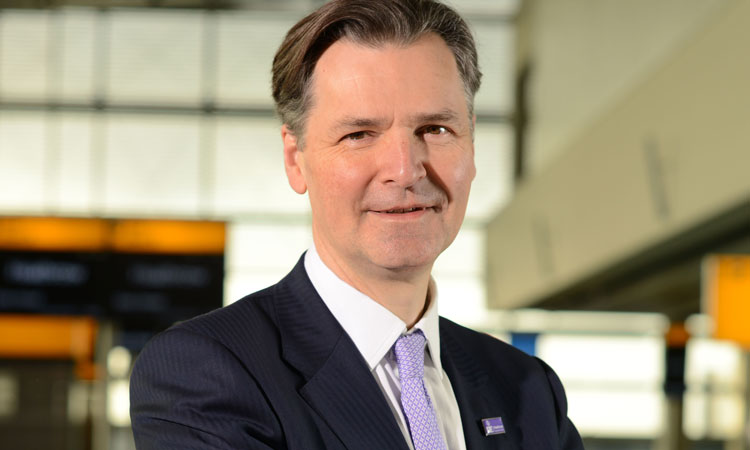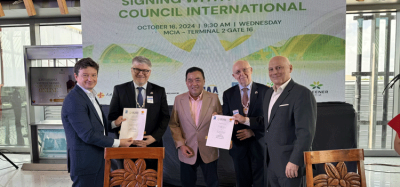Handling COVID-19 and safeguarding the airport for the future
- Like
- Digg
- Del
- Tumblr
- VKontakte
- Buffer
- Love This
- Odnoklassniki
- Meneame
- Blogger
- Amazon
- Yahoo Mail
- Gmail
- AOL
- Newsvine
- HackerNews
- Evernote
- MySpace
- Mail.ru
- Viadeo
- Line
- Comments
- Yummly
- SMS
- Viber
- Telegram
- Subscribe
- Skype
- Facebook Messenger
- Kakao
- LiveJournal
- Yammer
- Edgar
- Fintel
- Mix
- Instapaper
- Copy Link
Posted: 17 December 2020 | John Holland-Kaye | 2 comments
John Holland-Kaye, CEO of Heathrow Airport, stresses the importance of the industry working together on a Common International Standard for aviation health testing, because, once the pandemic is over, the next hurdle will be climate change.


2020 has been a year that those within the aviation sector had never thought possible. The impacts of COVID-19 have been collectively worse than the effects of 9/11, the last global recession, the Gulf War and the Icelandic ash cloud of 2010 combined. In January 2020, London Heathrow Airport (LHR) was enjoying its ninth year of consecutive growth and was Europe’s busiest airport.
The collapse in demand during March 2020 was staggering, as countries closed their borders. We worked with the rest of the international sector to make it safe to fly. We reviewed every step of the passenger journey, installed safety measures where needed and adopted pioneering technologies. These include UV cleaning robots – which kill bacteria and viruses – UV handrail technology, hand sanitiser stations and newly trained hygiene technicians to protect passengers and colleagues.
The feedback from passengers has been positive, and we know that the appetite to fly remains strong. The issue for aviation is that countries around the world have been cautious about reopening borders. In the initial stages of the pandemic, this was understandable. But, as we have learned more about how the disease is spread, and how we can detect it, we don’t need such blunt instruments as closed borders, or even blanket quarantine, to prevent transmission across borders. As the crisis has dragged on, the economic and social cost of lockdowns and closed borders is becoming more severe, as a health pandemic turns into an unemployment pandemic.
2020 has been a year that those within the aviation sector had never thought possible. The impacts of COVID-19 have been collectively worse than the effects of 9/11, the last global recession, the Gulf War and the Icelandic ash cloud of 2010 combined. In January 2020, London Heathrow Airport (LHR) was enjoying its ninth year of consecutive growth and was Europe’s busiest airport.
The collapse in demand during March 2020 was staggering, as countries closed their borders. We worked with the rest of the international sector to make it safe to fly. We reviewed every step of the passenger journey, installed safety measures where needed and adopted pioneering technologies. These include UV cleaning robots – which kill bacteria and viruses – UV handrail technology, hand sanitiser stations and newly trained hygiene technicians to protect passengers and colleagues.
The feedback from passengers has been positive, and we know that the appetite to fly remains strong. The issue for aviation is that countries around the world have been cautious about reopening borders. In the initial stages of the pandemic, this was understandable. But, as we have learned more about how the disease is spread, and how we can detect it, we don’t need such blunt instruments as closed borders, or even blanket quarantine, to prevent transmission across borders. As the crisis has dragged on, the economic and social cost of lockdowns and closed borders is becoming more severe, as a health pandemic turns into an unemployment pandemic.
2020 has been a year that those within the aviation sector had never thought possible. The impacts of COVID-19 have been collectively worse than the effects of 9/11, the last global recession, the Gulf War and the Icelandic ash cloud of 2010 combined.
We must remember that aviation is not just another industrial sector, it is the lifeblood of the global economy. A typical flight from Heathrow to Tokyo will carry Japanese businesspeople returning from visiting their factories in the UK, British consulting engineers going to visit clients, tourists and students and, under their feet, the cargo hold is taking high quality fresh salmon to the sushi markets within 24 hours of leaving the farm in Scotland. Without passenger planes flying, the UK’s economy is stuck in second gear, risking hundreds of thousands of jobs across the country.
Blanket bans and quarantines treat every passenger as if they have COVID-19. What we need is a Common International Standard for aviation health testing, just as we have for aviation security. Ultimately, this might be agreed at the International Civil Aviation Organization (ICAO), but we could make a great start if we could get consistency between the U.S., UK and European Union (EU). There is already some alignment developing on a ‘traffic light’ system, with free travel from ‘green’ low-risk countries, and tighter controls from ‘red’ high‑risk countries. But there is huge confusion over what those tighter controls should be.
Many countries have introduced testing for ‘red’ countries, which makes complete sense as a way to reopen the economy without introducing a health risk. The testing methodologies are getting faster and cheaper, and will soon become a routine part of life, at least until a vaccine is widespread. Some countries, including the UK, have been very slow to move to testing, and the impact can be seen in both the poor economic performance and the damage to their aviation sectors. Let us hope that this changes quickly for everyone’s sake.
Our industry has shown before how we can reinvent ourselves for the needs of tomorrow. Now is the time to do so again. This is Mission Possible!
But, even where testing is used, every country seems to have its own way of doing things: Different tests, different timings, different quarantine requirements. It is quickly becoming unmanageable for the sector and confusing for the passenger. We have shown in aviation security the benefits of having a common standard, and now we need to work collectively again. A Common International Standard for health should include pre‑departure testing for passengers from high-risk countries, but no quarantine on arrival. That gives each passenger the confidence that they can travel freely, but also removes any possibility of transmission during the journey because everyone will be known to be ‘COVID-free’. Global aviation can only work because there are common standards, and we are much better than many other sectors at working together. But we will need to, because, once we have tackled COVID-19, we will have an even bigger challenge to tackle: Climate change.
As a sector, we need to play our part in getting the world to net zero by 2050 – we cannot look our children in the eye and say we did nothing when we had a chance to act. There are many changes that we need to make as a sector – more efficient aircraft and engines, battery powered planes, shorter flight paths. But the single biggest change needed is to switch from fossil fuels to sustainable aviation fuel (SAF). This should be a flagship policy for the COP26 Climate Change Conference in November 2021, ahead of a global agreement at the ICAO General Assembly in September 2022. There is a global coalition of the willing coming together to support it. The entire UK aviation sector has signed up to a plan to get there, as has the oneworld airline alliance, as well as energy giants such as BP. Our industry has shown before how we can reinvent ourselves for the needs of tomorrow. Now is the time to do so again. This is Mission Possible!
John Holland-Kaye is the Chief Executive Officer of Heathrow Airport Holdings Ltd. During his time as CEO, Heathrow has consistently improved service levels for passengers, while reducing costs, and it is now rated one of the best airports in the world. Heathrow was named “Sustainable Business of the Year” at the 2019 edie awards and one of the Best Companies to Work For by the Sunday Times in 2017. Before becoming CEO in July 2014, he was Development Director, responsible for delivering the £2.5 billion Terminal 2 on time and on budget.



















I would appreciate news and articles on measures taken by the airports in the COVID and post-COVID periods.
Hi Shigeru. Thank you for your comment. You can find the most up to date news on airports and COVID-19 over on our COVID Hub – https://www.internationalairportreview.com/topic_hub/covid-19/
We have also launched a new online exclusive article series entitled: ‘Aviation’s Post-Crisis Recovery Series’, the first of which features Fort McMurray Airport which you can read here https://www.internationalairportreview.com/article/151078/aviation-post-crisis-recovery-fort-mcmurray-airport/
The article series is set to run every two weeks so watch this space for the next instalment!